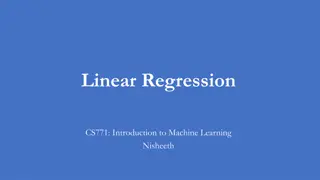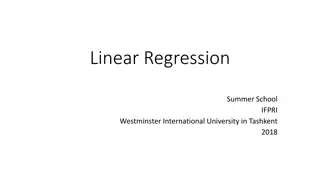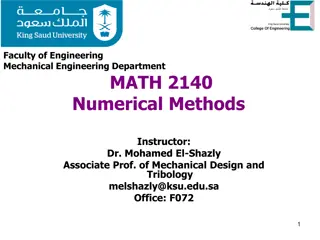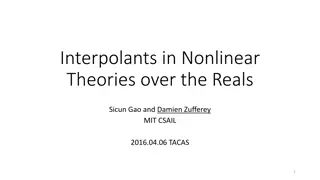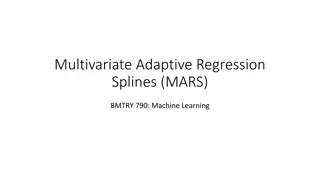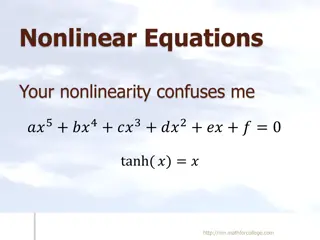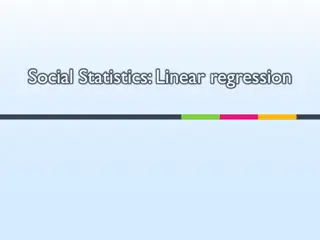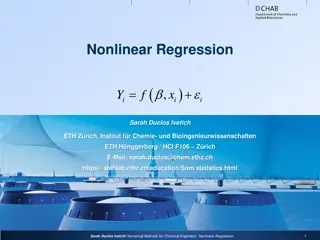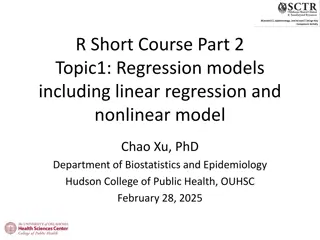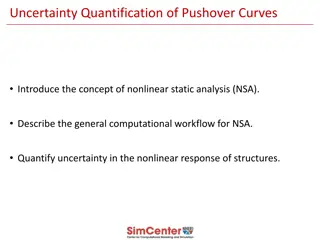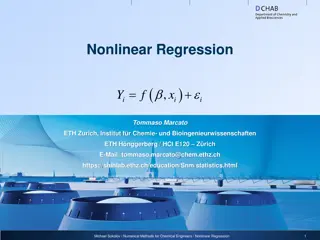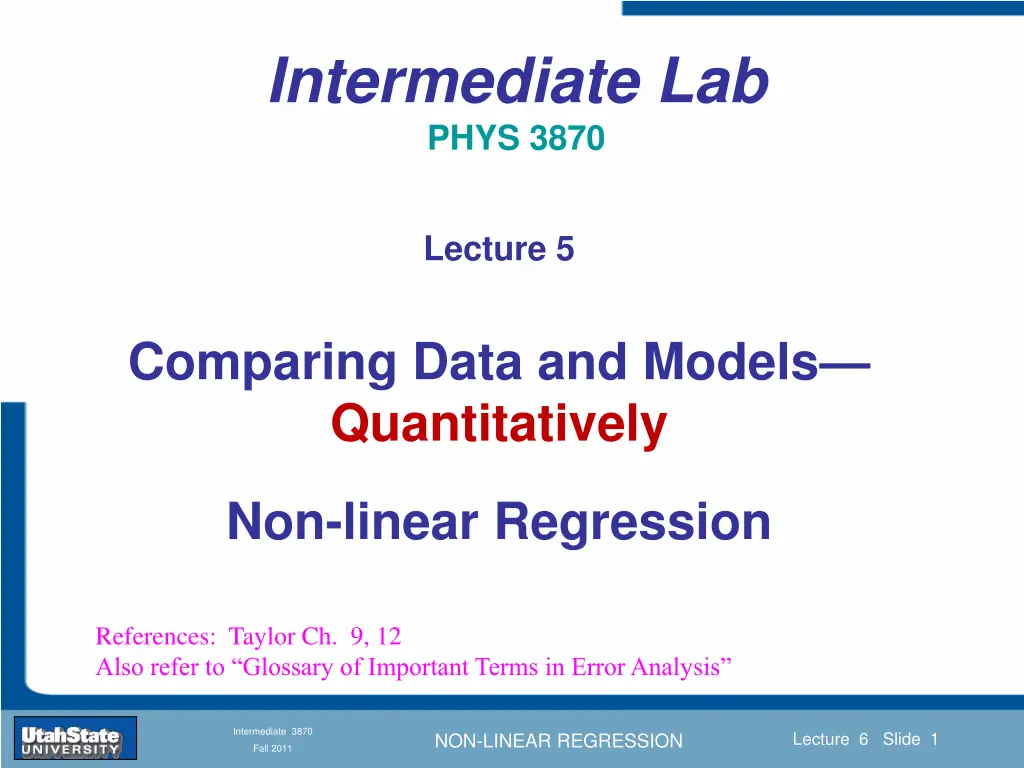
Understanding Errors in Measurements and Models for Modern Physics
Explore the quantification of precision and random errors, comparing data and models quantitatively, and analyzing non-linear regression in modern physics. Learn about systematic and random errors, the importance of accuracy and precision, and how to interpret multiple measurements effectively.
Download Presentation

Please find below an Image/Link to download the presentation.
The content on the website is provided AS IS for your information and personal use only. It may not be sold, licensed, or shared on other websites without obtaining consent from the author. If you encounter any issues during the download, it is possible that the publisher has removed the file from their server.
You are allowed to download the files provided on this website for personal or commercial use, subject to the condition that they are used lawfully. All files are the property of their respective owners.
The content on the website is provided AS IS for your information and personal use only. It may not be sold, licensed, or shared on other websites without obtaining consent from the author.
E N D
Presentation Transcript
Intermediate Lab PHYS 3870 Lecture 5 Comparing Data and Models Quantitatively Introduction Section 0 Lecture 1 Slide 1 Non-linear Regression INTRODUCTION TO Modern Physics PHYX 2710 References: Taylor Ch. 9, 12 Also refer to Glossary of Important Terms in Error Analysis Fall 2004 Intermediate 3870 Lecture 6 Slide 1 NON-LINEAR REGRESSION Fall 2011
Intermediate Lab PHYS 3870 Errors in Measurements and Models Introduction Section 0 Lecture 1 Slide 2 A Review of What We Know INTRODUCTION TO Modern Physics PHYX 2710 Fall 2004 Intermediate 3870 Lecture 6 Slide 2 NON-LINEAR REGRESSION Fall 2011
Quantifying Precision and Random (Statistical) Errors The best value for a group of measurements of the same quantity is the Average What is an estimate of the random error? Deviations A.If the average is the the best guess, then DEVIATIONS (or discrepancies) from best guess are an estimate of error B.One estimate of error is the range of deviations. Introduction Section 0 Lecture 1 Slide 3 INTRODUCTION TO Modern Physics PHYX 2710 Fall 2004 Intermediate 3870 Lecture 6 Slide 3 NON-LINEAR REGRESSION Fall 2011
Single Measurement: Comparison with Other Data Comparison of precision or accuracy? Introduction Section 0 Lecture 1 Slide 4 ?1 ?2 1 2 ?1+ ?2 ????????????????? = INTRODUCTION TO Modern Physics PHYX 2710 Fall 2004 Intermediate 3870 Lecture 6 Slide 4 NON-LINEAR REGRESSION Fall 2011
Single Measurement: Direct Comparison with Standard Introduction Section 0 Lecture 1 Slide 5 Comparison of precision or accuracy? ???????????? = ?????????? ?????? ?????? INTRODUCTION TO Modern Physics PHYX 2710 Fall 2004 Intermediate 3870 Lecture 6 Slide 5 NON-LINEAR REGRESSION Fall 2011
Multiple Measurements of the Same Quantity Our statement of the best value and uncertainty is: ( <t> t) sec at the 68% confidence level for N measurements 1. Note the precision of our measurement is reflected in the estimated error which states what values we would expect to get if we repeated the measurement 2. Precision is defined as a measure of the reproducibility of a measurement 3. Such errors are called random (statistical) errors 4. Accuracy is defined as a measure of who closely a Introduction Section 0 Lecture 1 Slide 6 measurement matches the true value 5. Such errors are called systematic errors INTRODUCTION TO Modern Physics PHYX 2710 Fall 2004 Intermediate 3870 Lecture 6 Slide 6 NON-LINEAR REGRESSION Fall 2011
Multiple Measurements of the Same Quantity Standard Deviation The best guess for the error in a group of N identical randomly distributed measurements is given by the standard deviation this is the rms (root mean squared deviation or (sample) standard deviation It can be shown that (see Taylor Sec. 5.4) t is a reasonable estimate of the uncertainty. In fact, for normal (Gaussian or purely random) data, it can be shown that (1)68% of measurements of t will fall within <t> t (2)95% of measurements of t will fall within <t> 2 t (3)98% of measurements of t will fall within <t> 3 t Introduction Section 0 Lecture 1 Slide 7 (4)this is referred to as the confidence limit Summary: the standard format to report the best guess and the limits within which you expect 68% of subsequent (single) measurements of t to fall within is <t> t INTRODUCTION TO Modern Physics PHYX 2710 Fall 2004 Intermediate 3870 Lecture 6 Slide 7 NON-LINEAR REGRESSION Fall 2011
Multiple Measurements of the Same Quantity Standard Deviation of the Mean If we were to measure t again N times (not just once), we would be even more likely to find that the second average of N points would be close to <t>. The standard error or standard deviation of the mean is given by This is the limits within which you expect the average of N addition Introduction Section 0 Lecture 1 Slide 8 measurements to fall within at the 68% confidence limit INTRODUCTION TO Modern Physics PHYX 2710 Fall 2004 Intermediate 3870 Lecture 6 Slide 8 NON-LINEAR REGRESSION Fall 2011
Errors in ModelsError Propagation Define error propagation [Taylor, p. 45] A method for determining the error inherent in a derived quantity from the errors in the measured quantities used to determine the derived quantity Recall previous discussions [Taylor, p. 28-29] I.Absolute error: ( <t> t) sec II.Relative (fractional) Error: <t> sec ( t/<t>)% III.Percentage uncertainty: fractional error in % units Introduction Section 0 Lecture 1 Slide 9 INTRODUCTION TO Modern Physics PHYX 2710 Fall 2004 Intermediate 3870 Lecture 6 Slide 9 NON-LINEAR REGRESSION Fall 2011
Specific Rules for Error Propogation Refer to [Taylor, sec. 3.2] for specific rules of error propagation: 1.Addition and Subtraction [Taylor, p. 49] For qbest=xbest ybest the error is q x+ y Follows from qbest q =(xbest x) (ybest y)= (xbest ybest) ( x y) 2.Multiplication and Division [Taylor, p. 51] For qbest=xbest * ybest the error is ( q/ qbest) ( x/xbest)+( y/ybest) 3.Multiplication by a constant (exact number) [Taylor, p. 54] For qbest= B(xbest ) the error is ( q/ qbest) |B| ( x/xbest) Follows from 2 by setting B/B=0 Introduction Section 0 Lecture 1 Slide 10 4.Exponentiation (powers) [Taylor, p.56] For qbest= (xbest )n the error is ( q/ qbest) n ( x/xbest) Follows from 2 by setting ( x/xbest)=( y/ybest) INTRODUCTION TO Modern Physics PHYX 2710 Fall 2004 Intermediate 3870 Lecture 6 Slide 10 NON-LINEAR REGRESSION Fall 2011
General Formula for Error Propagation General formula for uncertainty of a function of one variable x x Can you now derive for specific rules of error propagation: 1.Addition and Subtraction [Taylor, p. 49] 2.Multiplication and Division [Taylor, p. 51] 3.Multiplication by a constant (exact number) [Taylor, p. 54] 4.Exponentiation (powers) [Taylor, p. 56] [Taylor, Eq. 3.23] q = q Introduction Section 0 Lecture 1 Slide 11 INTRODUCTION TO Modern Physics PHYX 2710 Fall 2004 Intermediate 3870 Lecture 6 Slide 11 NON-LINEAR REGRESSION Fall 2011
General Formula for Multiple Variables Uncertainty of a function of multiple variables [Taylor, Sec. 3.11] 1. It can easily (no, really) be shown that (see Taylor Sec. 3.11) for a function of several variables + y x 2.More correctly, it can be shown that (see Taylor Sec. 3.11) for a function of several variables + y x where the equals sign represents an upper bound, as discussed above. 3.For a function of several independent and random variables q q q = + + ( , , ,...) ... q x y z x y z [Taylor, Eq. 3.47] z q q q + + ( , , ,...) ... q x y z x y z [Taylor, Eq. 3.47] z Introduction Section 0 Lecture 1 Slide 12 = z y x q 2 2 2 q q q + + + ( , , ,...) ... x y z [Taylor, Eq. 3.48] x y z INTRODUCTION TO Modern Physics PHYX 2710 Again, the proof is left for Ch. 5. Fall 2004 Intermediate 3870 Lecture 6 Slide 12 NON-LINEAR REGRESSION Fall 2011
Error Propagation: General Case Thus, if x and y are: a)Independent (determining x does not affect measured y) b)Random (equally likely for + x as x ) Then method the methods above overestimate the error Consider the arbitrary derived quantity q(x,y) of two independent random variables x and y. Expand q(x,y) in a Taylor series about the expected values of x and y (i.e., at points near X and Y). Fixed, shifts peak of distribution ? ?,? = ? ?,? + ?? ? ? + ?? (? ?) ?? ?? ? ? Fixed Distribution centered at X with width X Introduction Section 0 Lecture 1 Slide 13 Error for a function of Two Variables: Addition in Quadrature 2 2 INTRODUCTION TO Modern Physics PHYX 2710 ?? ?,? = ??= ?? + ?? ?? ??? ?? ?? Fall 2004 ? Intermediate 3870 Lecture 6 Slide 13 NON-LINEAR REGRESSION Fall 2011
Independent (Random) Uncertaities and Gaussian Distributions For Gaussian distribution of measured values which describe quantities with random uncertainties, it can be shown that (the dreaded ICBST), errors add in quadrature [see Taylor, Ch. 5] q x + y But, q = [( x)2 + ( y)2] 1.This is proved in [Taylor, Ch. 5] 2.ICBST [Taylor, Ch. 9] Method A provides an upper bound on the possible errors Introduction Section 0 Lecture 1 Slide 14 INTRODUCTION TO Modern Physics PHYX 2710 Fall 2004 Intermediate 3870 Lecture 6 Slide 14 NON-LINEAR REGRESSION Fall 2011
Gaussian Distribution Function Independent Variable Center of Distribution (mean) Distribution Function Normalization Constant Width of Distribution (standard deviation) Gaussian Distribution Function Introduction Section 0 Lecture 1 Slide 15 INTRODUCTION TO Modern Physics PHYX 2710 Fall 2004 Intermediate 3870 Lecture 6 Slide 15 NON-LINEAR REGRESSION Fall 2011
Standard Deviation of Gaussian Distribution See Sec. 10.6: Testing of Hypotheses 5 ppm or ~5 Valid for HEP 1% or ~3 Highly Significant 5% or ~2 Significant 1 Within errors Area under curve (probability that Introduction Section 0 Lecture 1 Slide 16 <x<+ ) is 68% INTRODUCTION TO Modern Physics PHYX 2710 Fall 2004 Intermediate 3870 Lecture 6 Slide 16 NON-LINEAR REGRESSION Fall 2011
Mean of Gaussian Distribution as Best Estimate Principle of Maximum Likelihood To find the most likely value of the mean (the best estimate of ), find X that yields the highest probability for the data set. Consider a data set {x1, x2, x3 xN } Each randomly distributed with The combined probability for the full data set is the product Introduction Section 0 Lecture 1 Slide 17 Best Estimate of X is from maximum probability or minimum summation Solve for derivative set to 0 Minimize Sum Best estimate of X INTRODUCTION TO Modern Physics PHYX 2710 Fall 2004 Intermediate 3870 Lecture 6 Slide 17 NON-LINEAR REGRESSION Fall 2011
Uncertaity of Best Estimates of Gaussian Distribution Principle of Maximum Likelihood To find the most likely value of the mean (the best estimate of ), find X that yields the highest probability for the data set. Consider a data set {x1, x2, x3 xN } The combined probability for the full data set is the product Best Estimate of X is from maximum probability or minimum summation Solve for derivative wrst X set to 0 Minimize Sum Best estimate of X Introduction Section 0 Lecture 1 Slide 18 Best Estimate of is from maximum probability or minimum summation Solve for derivative wrst set to 0 Best estimate of See Prob. 5.26 INTRODUCTION TO Modern Physics PHYX 2710 Minimize Sum Fall 2004 Intermediate 3870 Lecture 6 Slide 18 NON-LINEAR REGRESSION Fall 2011
Weighted Averages Question: How can we properly combine two or more separate independent measurements of the same randomly distributed quantity to determine a best combined value with uncertainty? Introduction Section 0 Lecture 1 Slide 19 INTRODUCTION TO Modern Physics PHYX 2710 Fall 2004 Intermediate 3870 Lecture 6 Slide 19 NON-LINEAR REGRESSION Fall 2011
Weighted Averages The probability of measuring two such measurements is ????? ?1,?2= ????? ?1????? ?2 1 ?1?2? ?2/2? ????2 ?1 ? To find the best value for X, find the maximum Prob or minimum X2 Best Estimate of is from maximum probibility or minimum summation 2+ ?2 ? 2 = ?1 ?2 Solve for derivative wrst set to 0 Minimize Sum Solve for best estimate of This leads to = ???? ?? ??_???= ?1?1+ ?2?2 ? ?????= 1 ??2 ?1+ ?2 Introduction Section 0 Lecture 1 Slide 20 Note: If w1=w2, we recover the standard result Xwavg= (1/2) (x1+x2) 1 Finally, the width of a weighted average distribution is ????? ??????= INTRODUCTION TO Modern Physics PHYX 2710 ?? ? Fall 2004 Intermediate 3870 Lecture 6 Slide 20 NON-LINEAR REGRESSION Fall 2011
Intermediate Lab PHYS 3870 Comparing Measurements to Linear Models Introduction Section 0 Lecture 1 Slide 21 Summary of Linear Regression INTRODUCTION TO Modern Physics PHYX 2710 Fall 2004 Intermediate 3870 Lecture 6 Slide 21 NON-LINEAR REGRESSION Fall 2011
Question 1: What is the Best Linear Fit (A and B)? Best Estimate of intercept, A , and slope, B, for For the linear model y = A + B x Intercept: Slope Introduction Section 0 Lecture 1 Slide 22 Linear Regression or Least Squares- Fit for Line INTRODUCTION TO Modern Physics PHYX 2710 where Fall 2004 Intermediate 3870 Lecture 6 Slide 22 NON-LINEAR REGRESSION Fall 2011
Best Estimates of Linear Fit Consider a linear model for yi, yi=A+Bxi The probability of obtaining an observed value of yi is ?????,? ?1 ??= ?????,? ?1 ?????,? ?? ???? ?2/2? ????2 ?? (? + ???)2 To find the best simultaneous values for A and B, find the maximum Prob or minimum X2 ? 1 = ??2 ?=1 Best Estimates of A and B are from maximum probibility or minimum summation Solve for derivative wrst A and B set to 0 Minimize Sum Best estimate of A and B Introduction Section 0 Lecture 1 Slide 23 INTRODUCTION TO Modern Physics PHYX 2710 Fall 2004 Intermediate 3870 Lecture 6 Slide 23 NON-LINEAR REGRESSION Fall 2011
Best Estimates of Linear Fit Best Estimates of A and B are from maximum probibility or minimum summation Solve for derivative wrst A and B set to 0 Minimize Sum Best estimate of A and B For the linear model y = A + B x Intercept: ? = Slope ?2 ? ? ?? ? ?2 ? 2 ?2 ? ?2 ? 2(Prob (8.16) ??= ?? ? ?? ? ?? ? ?2 ? 2 ? Introduction Section 0 Lecture 1 Slide 24 ? = ??= ?? ? ?2 ? 2 INTRODUCTION TO Modern Physics PHYX 2710 1 ? 2 ?? ? + ???2 where ??= Fall 2004 Intermediate 3870 Lecture 6 Slide 24 NON-LINEAR REGRESSION Fall 2011
Correlation Coefficient Combining the Schwartz inequality With the definition of the covariance The uncertainty in a function q(x,y) is With a limiting value At last, the upper bound of errors is Introduction Section 0 Lecture 1 Slide 25 And for independent and random variables 2 2 q q = + q x y x y INTRODUCTION TO Modern Physics PHYX 2710 Fall 2004 Intermediate 3870 Lecture 6 Slide 25 NON-LINEAR REGRESSION Fall 2011
Question 2: Is it Linear? y(x) = A + B x ??? ???? ? ? ? ? ? ? 2 ? ? 2= Introduction Section 0 Lecture 1 Slide 26 Coefficient of Linear Regression: ? Consider the limiting cases for: INTRODUCTION TO Modern Physics PHYX 2710 r=0 (no correlation) [for any x, the sum over y-Y yields zero] r= 1 (perfect correlation). [Substitute yi-Y=B(xi-X) to get r=B/|B|= 1] Fall 2004 Intermediate 3870 Lecture 6 Slide 26 NON-LINEAR REGRESSION Fall 2011
Tabulated Correlation Coefficient r value N data points Consider the limiting cases for: r=0 (no correlation) r= 1 (perfect correlation). To gauge the confidence imparted by intermediate r values consult the table in Appendix C. Probability that analysis of N=70 data points with a correlation coefficient of r=0.5 is not modeled well by a linear relationship is 3.7%. Therefore, it is very probably that y is linearly related to x. If ProbN(|r|>ro)<32% it is probably that y is linearly related to x ProbN(|r|>ro)<5% it is very probably that y is linearly related to x ProbN(|r|>ro)<1% it is highly probably that y is linearly related to x Introduction Section 0 Lecture 1 Slide 27 INTRODUCTION TO Modern Physics PHYX 2710 Fall 2004 Intermediate 3870 Lecture 6 Slide 27 NON-LINEAR REGRESSION Fall 2011
Uncertainties in Slope and Intercept Taylor: For the linear model y = A + B x Intercept: ? = Slope ? = ?2 ? ? ?? ? ?2 ? 2 ?2 ? ?2 ? 2(Prob (8.16) ??= ?? ? ?? ? ?? ? ?2 ? 2 ? ??= ?? ? ?2 ? 2 1 where ??= ? 2 ?? ? + ???2 Relation to R2 value: Introduction Section 0 Lecture 1 Slide 28 INTRODUCTION TO Modern Physics PHYX 2710 Fall 2004 Intermediate 3870 Lecture 6 Slide 28 NON-LINEAR REGRESSION Fall 2011
Intermediate Lab PHYS 3870 Comparing Measurements to Models Non-Linear Regression Introduction Section 0 Lecture 1 Slide 29 INTRODUCTION TO Modern Physics PHYX 2710 Fall 2004 Intermediate 3870 Lecture 6 Slide 29 NON-LINEAR REGRESSION Fall 2011
Motivating Regression Analysis Question: Consider now what happens to the output of a nearly ideal experiment, if we vary how hard we poke the system (vary the input). Uncertainties in Observations Input Output SYSTEM The Universe Introduction Section 0 Lecture 1 Slide 30 A more general model of response is a nonlinear response model y(x) = f(x) INTRODUCTION TO Modern Physics PHYX 2710 Fall 2004 Intermediate 3870 Lecture 6 Slide 30 NON-LINEAR REGRESSION Fall 2011
Questions for Regression Analysis A more general model of response is a nonlinear response model y(x) = f(x) Two principle questions: What are the best values of a set of fitting parameters, What confidence can we place in how well the general model fits the data? The solutions is familiar: Evoke the Principle of Maximum Likelihood, Minimize the summation of the exponent arguments, that is chi squared? Recall what this looked like for a model with a constant value, linear model, polynomial model, and now a general nonlinear model Introduction Section 0 Lecture 1 Slide 31 INTRODUCTION TO Modern Physics PHYX 2710 Fall 2004 Intermediate 3870 Lecture 6 Slide 31 NON-LINEAR REGRESSION Fall 2011
Chi Squared Analysis for Least Squares Fit General definition for Chi squared (square of the normalized deviations) Perfect model Good model Poor model Discrete distribution Introduction Section 0 Lecture 1 Slide 32 Continuous distribution INTRODUCTION TO Modern Physics PHYX 2710 Fall 2004 Intermediate 3870 Lecture 6 Slide 32 NON-LINEAR REGRESSION Fall 2011
Expected Values for Chi Squared Analysis or If the model is good , each term in the sum is ~1, so i More correctly the sum goes to the number of degrees of freedom, d N-c. Introduction Section 0 Lecture 1 Slide 33 The reduced Chi-squared value is So red2=0 for perfect fit red2<1 for good fit red2>1 for poor fit (looks a lot like r for linear fits doesn t it?) i INTRODUCTION TO Modern Physics PHYX 2710 Fall 2004 Intermediate 3870 Lecture 6 Slide 33 NON-LINEAR REGRESSION Fall 2011
Chi Squared Analysis for Least Squares Fit From the probability table ~99.5% (highly significant) confidence Introduction Section 0 Lecture 1 Slide 34 INTRODUCTION TO Modern Physics PHYX 2710 Fall 2004 Intermediate 3870 Lecture 6 Slide 34 NON-LINEAR REGRESSION Fall 2011
Probabilities for Chi Squared Introduction Section 0 Lecture 1 Slide 35 INTRODUCTION TO Modern Physics PHYX 2710 Fall 2004 Intermediate 3870 Lecture 6 Slide 35 NON-LINEAR REGRESSION Fall 2011
Reduced Chi Squared Analysis Introduction Section 0 Lecture 1 Slide 36 INTRODUCTION TO Modern Physics PHYX 2710 Fall 2004 Intermediate 3870 Lecture 6 Slide 36 NON-LINEAR REGRESSION Fall 2011
Problem 12.2 Introduction Section 0 Lecture 1 Slide 37 INTRODUCTION TO Modern Physics PHYX 2710 Fall 2004 Intermediate 3870 Lecture 6 Slide 37 NON-LINEAR REGRESSION Fall 2011
Problem 12.2 Introduction Section 0 Lecture 1 Slide 38 INTRODUCTION TO Modern Physics PHYX 2710 Fall 2004 Intermediate 3870 Lecture 6 Slide 38 NON-LINEAR REGRESSION Fall 2011


